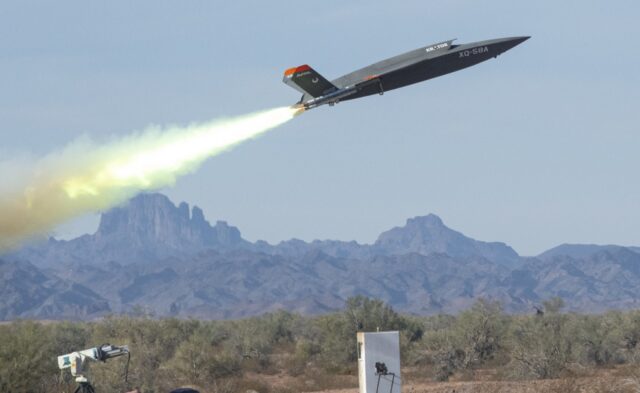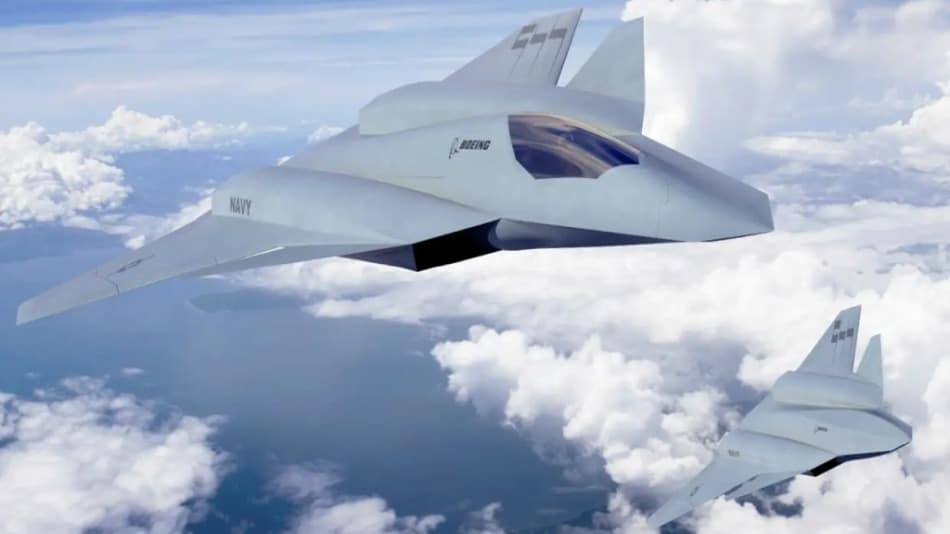US Air Force Secretary Frank Kendall revealed another batch of information about the Next Generation Air Dominance fighter jet program in several statements last month. It turns out that, contrary to the words of Kendall himself, which we wrote about in June, the program has not yet entered the engineering and manufacturing development phase. However, the schedule remains extremely ambitious and provides for initial operational readiness to be achieved by 2030.
For example, the B-21 Raider strategic bomber is in the EMD phase and its flight is expected next year. On average, in the US Air Force, about seven years pass from the start of the EMD phase – referred to as the “B” Milestone – to the announcement of initial operational readiness. This means that if NGAD had actually reached this stage, operational readiness in 2030 would be an achievable goal. But now Kendall had to admit that he… made a slip.
“I’m an old-fashioned guy,” said 73-year-old Kendall at the Defense News Conference on September 7, “I’ve been dealing with these issues for a long time, and I still think about engineering and manufacturing development in terms of the phase in which you are working on a new project.”
Both Kendall and his procurement assistant Andrew Hunter emphasize that the plan to bring NGAD into service this decade has not changed. Interestingly, the first to be delivered to the US Air Force is not the manned platform constituting the core of the NGAD systems system, but its unmanned wing loyal to it. In the US Air Force, these drones have been adorned with the charming term “collaborative combat aircraft – collaborative combat aircraft.”
The Next Generation Air Dominance program isn’t in EMD after all, SECAF Frank Kendall said this month, clarifying his comments earlier this summer.
But this has some experts wondering: Can the Air Force meet its 2030 goal for NGAD? New on @defense_news: https://t.co/FNaxKyGYSW pic.twitter.com/HlqyHricLe
– Stephen Loose-eye 🧟🎃 (@StephenLosey) September 27, 2022
Kendall’s antiquity, however, has raised concerns in the American aviation community. Since NGAD has yet to enter the EMD phase, when will it be? And is there enough time to put the aircraft into service by 2030? And if not – will the Pentagon stick to this deadline and force its engineers to hurry, which could damage the quality of the construction?
Among the doubters is Retired Major Heather Penney, who became famous twenty-one years ago in an attempt to prevent the 9/11 attacks and is now an analyst at the Mitchell Institute for Aerospace Studies think tank.
Schematic diagram of the FCAS program for next-generation fighters working with unmanned aerial vehicles, satellites and older aircraft.
(Airbus)
“I am very skeptical that NGAD will reach its full-scale production decision, the” C “Milestone, by the end of the decade, says Penney. – It would be realistic to expect full-scale production to start only in the 1930s. But I wish the air force could prove me wrong.
Milestone “C” marks the end of the EMD phase. It is here that the decision is made whether the project will go to series production and line service.
Regardless of which of the many concepts it will be implemented in, the NGAD is to be the first sixth generation combat aircraft and is to revolutionize the air battlefield. Against its background, even the F-22A Raptor is to remain far behind. But, of course, it is not the Raptor that will be fighting NGAD; his main opponent will be Chinese fighters. Hence, concerns that the Pentagon will insist on meeting the AD 2030 deadline at all costs, as it cannot be concealed that the US air force is in a rush.

The raptors will still be modernized, but we’ll start saying goodbye to them in the next decade.
(US Air Force / Staff Sgt. Don Hudson)
“I can’t tell you what’s going on in China except that they are getting ready for the 20th Congress of the Chinese Communist Party,” said Air Combat Command chief General Mark Kelly. – But I can tell you what’s not happening. They don’t debate usefulness [samolotów] sixth generation air superiority. I can also tell you that they are moving forward.
Already three years ago, Wang Haifeng, head of the Chengdu Aerospace Corporation, which produces, among other things, J-20 fighters, admitted that China is undergoing preliminary work on a next-generation fighter plane that could enter service by 2035. According to Wang, also in the Middle Kingdom, the sixth generation means the possibility of extensive cooperation with drones, the use of artificial intelligence or further improvement of situational awareness thanks to the use of sensors working in all directions, and potentially also laser weapons or swarms of drones.

The XQ-58A Valkyrie – the work of Kratos Defense & Security Solutions, flown on March 5, 2019 – is to be a low-cost solution capable of operating both as a loyal wingman and as a fully autonomous combat agent (also in a swarm).
(US Air Force / Staff Sgt. Joshua King)
Of course, the Americans have much more experience than the Chinese in the field of fifth-generation combat aircraft. The F-22 is a mature design, approaching the end of line service, and the F-35 has already solidified and left behind most of the most important childhood problems (though not all). In addition, the experience of working on the hard-to-detect B-2 Spirit and B-21 Raider bombers can also be used in the development of the air superiority fighter. China does not have such a possibility. Although work is underway there on the H-20 bomber, it is not known when its flight can be expected, let alone entering service.
General Kelly emphasized that all indications were that the doctrinal differences between the sixth generation in Chinese and the sixth generation in the US will be minimal. The path in which the two countries achieve this goal may differ – the Americans, according to Kelly, are betting on risky big leaps and revolutionary changes, while the Chinese will rather take safer steps – but the end result may be almost identical and achieved in a similar time.
Kelly cites the example of the Su-27 family here. China became the first foreign (not counting the former components of the USSR) user of fighters of this type in their basic version in 1992. On their basis, the license production of the J-11 and J-11A fighter versions and the nominally multipurpose J-11B, and then the fully multi-purpose J-16 with native Shenyang WS-10 engines, was launched. The Chinese are now successfully developing their own branch of the Su-27 family with almost no Russian participation. Almost – because, according to Kelly, the purchase of a small batch of Su-35 was supposed to give the Chinese access to the modern avionics package of this machine in order to copy and modernize it on their own.
Sexy J-16 photograph with WS-10B engine [1920×1080] from / u / 1104777236 at #WarplanePorn ➡ https://t.co/8dJmz5gIXM pic.twitter.com/xaRDRc083U
– WarplanePorn (@warplane_porn) September 28, 2022
US Pacific Air Force Commander General Kenneth Wilsbach does not agree. In his opinion, the real threat lies in the Chinese fifth generation, i.e. the J-20, which, however, he does not consider to be a particularly dangerous opponent. Ultimately, the greatest strength of the J-20, according to Wilsbach, may be its size, compared to American fifth-generation aircraft.
Kelly, however, emphasizes that the Chinese did not fall out of the tail, and although they rely on Russian achievements, they are able to successfully develop them on their own using the method of small steps. The Chinese loyal winger program also appears to be doing well despite being kept in the shadows. Last year, the FH-97 unmanned aerial vehicle was revealed. The concept of a drone called Anjian (in English: Dark Sword) has also been known for several years, but apparently it has not yet reached the stage of a full-size mock-up. It is also known that work has been initiated on the equivalent of the American project Skyborg, i.e. artificial intelligence for unmanned aerial vehicles.
AnJian (Dark Sword) will be # PLAAF’s #LoyalWingman UAV for Manned Unmanned Teaming (MUM-T) Ops a decade fm now. The Chinese drone is under development & has a stealthy airframe in a twin engine configuration, with internal weapon’s bay for AA / AG stores. #MUT #ComethTheSwarm pic.twitter.com/7MQweREse5
– Sameer Joshi (@joe_sameer) August 8, 2020
Money can play a decisive role in the race for the sixth generation. Kendall testified through the House of Representatives Armed Forces Committee that a single NGAD manned fighter is projected to cost several hundred million dollars. Even with the most optimistic interpretation of these words, it means that each NGAD will be more than twice as expensive as the F-35A Lightning II. Kendall emphasizes that the price should go hand in hand with unprecedented effectiveness on the battlefield. However, in order to be able to take full advantage of this platform, it will have to be accompanied in the air by cheaper machines – unmanned aircraft loyal to the wing. The price of the latter, even an estimate, is unknown, but Kendall himself has mentioned that one loyal winger will cost about half what an NGAD paired with him. This sounds encouraging, until you consider that in practice this would mean a drone price of at least the F-35A price.
The philosophy behind NGAD and the rationale behind a tight schedule and an exorbitant price were best summed up by Kendall at the Defense News Conference when asked if the country could afford a platform costing several hundred million dollars apiece.
– Can our country afford not to have control in the air? The secretary asked rhetorically. – We must have air control.
See also: ANN for Australia – British or American?
Boeing

